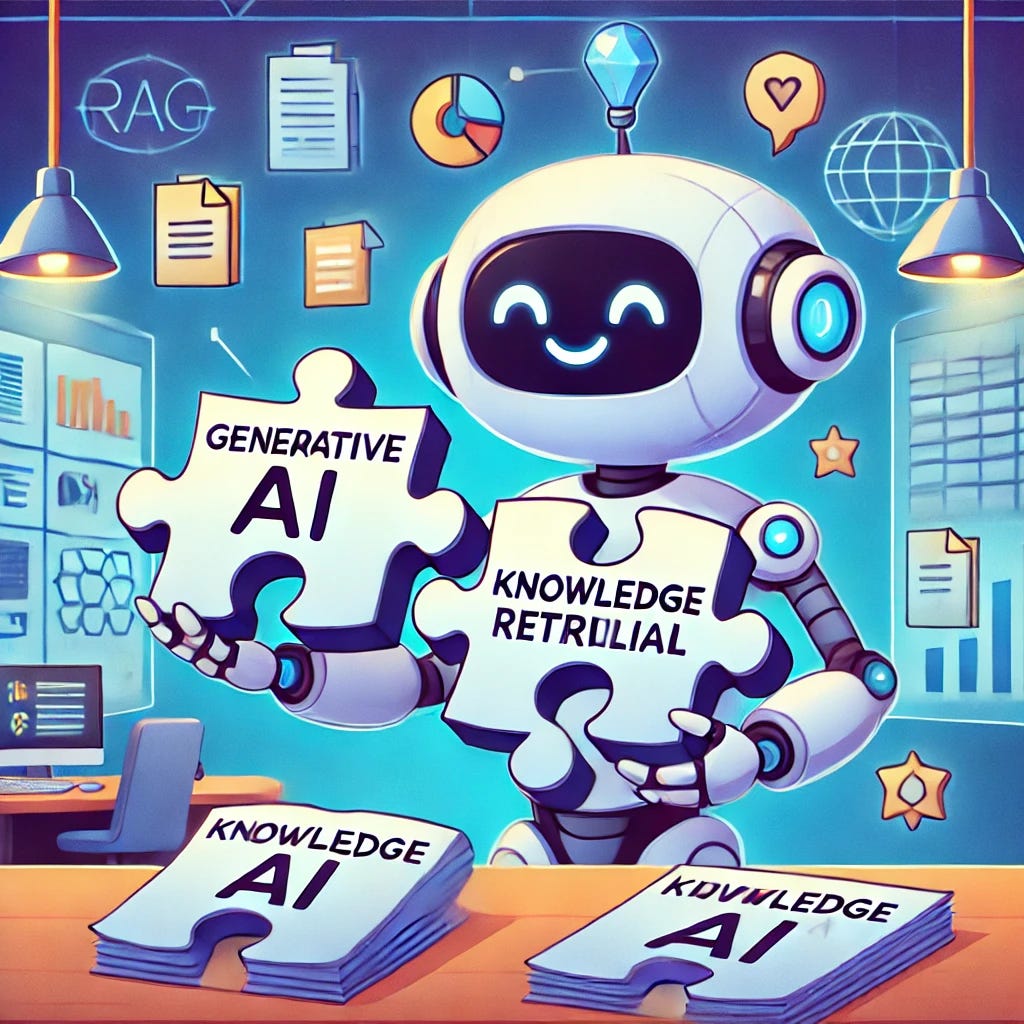How RAG Completes the Puzzle for Enterprise AI Applications
In the ever-evolving landscape of enterprise AI, Retrieval-Augmented Generation (RAG) is emerging as a powerful tool that bridges the gap between generative AI and real-time knowledge integration...
In the ever-evolving landscape of enterprise AI, Retrieval-Augmented Generation (RAG) is emerging as a powerful tool that bridges the gap between generative AI and real-time knowledge integration. Enterprises often struggle with how to manage AI models that, while impressive, sometimes provide outdated or incorrect information. This is where RAG steps in, enabling AI to retrieve and incorporate the most current and domain-specific knowledge, ensuring that responses are accurate, relevant, and grounded in real data.
In this post, we’ll explore how RAG works, why it’s a game-changer for enterprise applications, and we’ll break down a practical scenario demonstrating how RAG can enhance AI solutions.
What is RAG and Why Does It Matter?
Retrieval-Augmented Generation (RAG) combines the strengths of information retrieval and text generation. Traditional LLMs like GPT-3 or BERT generate text based on their training data, which can quickly become outdated or lack the specific information required for niche enterprise applications. With RAG, the model retrieves up-to-date, relevant data from external sources (such as databases, APIs, or documents) and integrates it with the generative capabilities of the LLM.
This solves two major problems:
Outdated Knowledge: LLMs struggle to stay current with real-world information after their initial training.
Contextual Relevance: Many AI models hallucinate answers when they lack domain-specific context, which can be problematic in fields like healthcare or finance.
RAG solves these issues by allowing the model to fetch and incorporate relevant knowledge on the fly, making it ideal for enterprise applications where accuracy and context matter most
Gradient: AI Automation for Enterprise
How RAG Works in an Enterprise Context
Let’s walk through the RAG workflow, broken down into five key steps:
Embedding Enterprise Knowledge
First, domain-specific knowledge is converted into vector embeddings (numerical representations) using an embedding model. This step is essential for making the data retrievable based on semantic similarity.Code Example for Embedding:
from sentence_transformers import SentenceTransformer
# Load a pre-trained model to generate vector embeddings
model = SentenceTransformer('paraphrase-MiniLM-L6-v2')
# Sample enterprise document
docs = ["Annual tax regulations 2024", "Employee leave policy document"]
# Generate embeddings for the documents
embeddings = model.encode(docs)
User Query
The user submits a question or request, for example:
"What are the latest tax regulations for 2024?"Retrieving Relevant Information
RAG retrieves contextually relevant chunks of data from the knowledge base using the query’s vector representation. It searches the vector database for information semantically similar to the query.Code Example for Retrieval:
import pinecone
# Connect to a vector database (e.g., Pinecone)
pinecone.init(api_key='your-api-key', environment='us-west1-gcp')
# Create a new index or connect to an existing one
index = pinecone.Index("knowledge-base")
# Retrieve relevant documents based on user query embedding
query_embedding = model.encode("Latest tax regulations 2024")
result = index.query(query_embedding, top_k=3)
Augmenting the Query
The retrieved information is then concatenated with the user’s original query to form a more context-aware prompt, providing the LLM with the necessary background to generate a coherent and accurate response.
Graph of the RAG Process:
User Query ---> Retrieve Relevant Knowledge ---> Augment Query ---> Generate Answer
| |
Vector Database Large Language ModelText Generation
Finally, the LLM generates a response based on the augmented prompt, incorporating the newly retrieved knowledge. This ensures that the response is accurate, domain-specific, and grounded in the latest data.
Output Example:
"The tax rate for dividends in 2024 is 15%. For more details, please refer to the official guide on tax regulations."
Why RAG is Essential for Enterprise AI
1. Up-to-Date Information
Traditional models can fall behind in fast-paced industries. With RAG, companies can keep their AI systems current by retrieving live data from internal databases or APIs, meaning the model doesn’t rely solely on old training data
2. Cost-Efficient and Scalable
RAG eliminates the need for continuous fine-tuning or retraining every time new information becomes available. It also reduces the high costs associated with training large language models, as the model can access external data without being retrained on it
3. Trust and Traceability
RAG enhances user trust by grounding responses in factual, retrievable data. It even allows AI systems to cite their sources, improving auditability and transparency in sectors like healthcare, finance, or legal compliance
Gradient: AI Automation for Enterprise
Practical Example: RAG in Action for a Healthcare Provider
Let’s say a healthcare company deploys RAG to help their customer support team answer complex questions about patient care regulations. Here’s how RAG could work in this context:
User Query:
A patient asks, “What are the updated COVID-19 vaccination protocols for 2024?”Retrieval:
The RAG system retrieves the latest vaccination guidelines and any recent changes from the company’s internal healthcare repository and official government sources.Augmentation:
The retrieved documents are then augmented with the patient’s original question to ensure the LLM has all the relevant context.Generated Response:
The AI system responds with, “The 2024 COVID-19 vaccination protocol includes a single booster dose for adults. You can find the updated guidelines [here].”
Conclusion: How RAG Completes the AI Puzzle
RAG doesn’t just augment generation with external knowledge—it completes the AI puzzle for enterprises, making generative models more relevant, trustworthy, and scalable. By bridging the gap between pre-trained models and dynamic, real-time data, RAG empowers organizations to deliver better AI solutions without the constant overhead of retraining.
For industries that depend on accuracy, up-to-date information, and domain specificity, RAG is a must-have. It’s not just the future of enterprise AI—it’s the present.
This blog is designed to explain RAG in a clear, practical manner, with code snippets and a real-world example to help users visualize how the system works in enterprise applications. Let me know if you'd like to expand further on any specific aspects!




